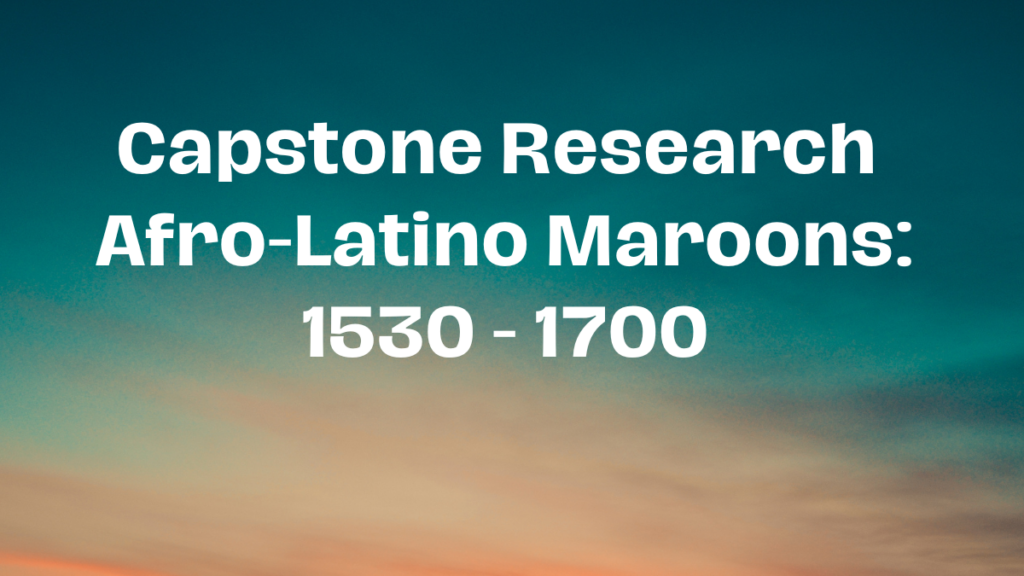
At Not Even Past, we are always delighted to highlight superb undergraduate research. Below we feature a project drawn from Dr. Jorge Cañizares-Esguerra‘s capstone undergraduate seminar which was taught in Fall 2023. The course was a hybrid with roughly half focused on reading secondary and primary sources and half devoted to an independent research project. Below we feature Leo Filyk’s fascinating capstone project, Afro-Latino Maroons: 1530 – 1700.
In his introductory essay to Maroon Societies: Rebel Slave Communities in the Americas (1996), Richard Price attempts some generalizations “comparing African maroon societies in a time perspective;” that is, their changing characteristics between the 16th and 18th centuries (37):
Communities formed in the sixteenth or seventeenth centuries seem to have differed from those formed later, both in the types of men they chose as leaders and in the models used to legitimize their authority. Before 1700, the great majority of maroon leaders on whom we have data were African-born. Moreover, four of the six major leaders (Ganga Zumba, Domingo Bioho, Yanga, and Bayano) claimed to have been kings in their African homelands. During this period, models of monarchy were frequently appealed to… In contrast, after the beginning of the eighteenth century, maroon leaders only very rarely claimed princely descent from Africa, tending instead to style themselves captains, governors, or colonels rather than kings. Moreover, a striking number of leaders during this period were Creoles, quite out of proportion to the number of American-born men in the general slave population… I would like to suggest, particularly for this period, that the nature of maroon (and colonial) society made the person who was skilled at understanding whites, as well as his fellow maroons, especially valuable as a leader (19-20).

Through the course of this essay, I will argue against Price’s framework, contending that the features he relates to 18th century maroon communities, namely the Hispanicized leadership and extensive knowledge of whites, were already prominent characteristics of certain maroon societies in the 16th and 17th centuries. Using, in particular, primary sources on maroons from 16th century Panama, along with a number of primary sources involving maroons in 16th century Ecuador and 17th century Colombia, I maintain that a subset of Spanish American maroon communities in the 16th and 17th centuries had highly acculturated, or ladino, leaders, who effectively used their knowledge of Hispanic language and culture to defend their communities. Additionally, some of the traditional, African-inspired monarchical leaders of this earlier era were more Hispanicized than Price’s comparison between the centuries may suggest. These acculturated maroon leaders, of which some, in fact, were American criollos (American-born), showcased an ability to speak and/or write Spanish, allowing them to send personal letters to colonial authorities. They demonstrated to those officials their Catholic piety and an understanding of what behavior, ideas, and rhetoric would appeal to them.
In making these arguments, I do not mean to suggest that maroons displaying an extensive knowledge or assimilated identity around Hispanic language, culture, and religion, took on such characteristics at the expense of African language, culture, and religion. Rather, as scholarship on the formation of New World identities has shown, African slaves were both highly adaptive and resilient in combining aspects of Hispanic culture — which oftentimes was introduced to them on the African coast or ingrained in societies like the Kongo — with their personal, native African culture and worldview (Berlin; Lovejoy; Mintz and Price). African-born slaves transported to the New World, who made up the large majority of maroon communities and their leaders in the 16th and 17th centuries, retained their African identities, including the practice of traditional rituals, even as they mixed with those identities aspects of Spanish culture and the cultures of diverse African tribal heritages brought together through the slave trade. Religious and cultural syncretism were obviously key characteristics of the African, New World experience.
Read the whole project here